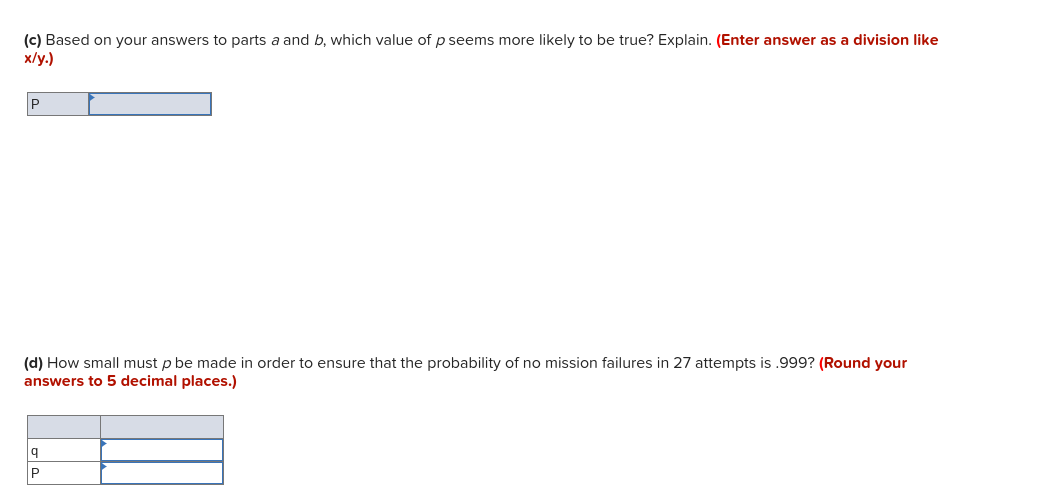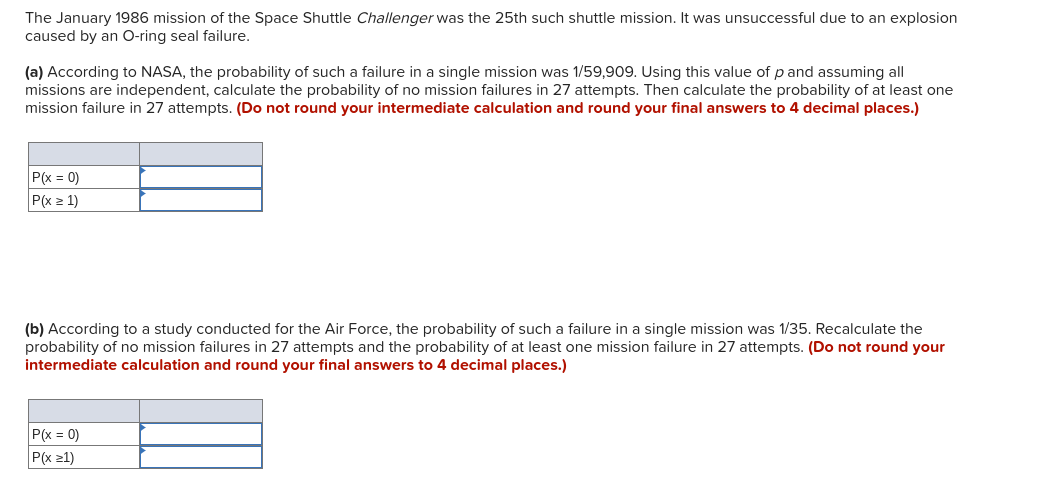(c) Based on your answers to parts a and b, which value of p seems more likely to be true? Explain. (Enter answer as a division like x/y.) (d) How small must p be made in order to ensure that the probability of no mission failures in 27 attempts is .999? (Round your answers to 5 decimal places.)
(c) Based on your answers to parts a and b, which value of p seems more likely to be true? Explain. (Enter answer as a division like x/y.) (d) How small must p be made in order to ensure that the probability of no mission failures in 27 attempts is .999? (Round your answers to 5 decimal places.)
Holt Mcdougal Larson Pre-algebra: Student Edition 2012
1st Edition
ISBN:9780547587776
Author:HOLT MCDOUGAL
Publisher:HOLT MCDOUGAL
Chapter11: Data Analysis And Probability
Section: Chapter Questions
Problem 8CR
Related questions
Topic Video
Question

Transcribed Image Text:(c) Based on your answers to parts a and b, which value of p seems more likely to be true? Explain. (Enter answer as a division like
x/y.)
P
(d) How small must p be made in order to ensure that the probability of no mission failures in 27 attempts is .999? (Round your
answers to 5 decimal places.)
P

Transcribed Image Text:The January 1986 mission of the Space Shuttle Challenger was the 25th such shuttle mission. It was unsuccessful due to an explosion
caused by an O-ring seal failure.
(a) According to NASA, the probability of such a failure in a single mission was 1/59,909. Using this value of pand assuming all
missions are independent, calculate the probability of no mission failures in 27 attempts. Then calculate the probability of at least one
mission failure in 27 attempts. (Do not round your intermediate calculation and round your final answers to 4 decimal places.)
P(x = 0)
P(x 2 1)
(b) According to a study conducted for the Air Force, the probability of such a failure in a single mission was 1/35. Recalculate the
probability of no mission failures in 27 attempts and the probability of at least one mission failure in 27 attempts. (Do not round your
intermediate calculation and round your final answers to 4 decimal places.)
P(x = 0)
P(x 21)
Expert Solution
This question has been solved!
Explore an expertly crafted, step-by-step solution for a thorough understanding of key concepts.
This is a popular solution!
Trending now
This is a popular solution!
Step by step
Solved in 6 steps

Knowledge Booster
Learn more about
Need a deep-dive on the concept behind this application? Look no further. Learn more about this topic, statistics and related others by exploring similar questions and additional content below.Recommended textbooks for you

Holt Mcdougal Larson Pre-algebra: Student Edition…
Algebra
ISBN:
9780547587776
Author:
HOLT MCDOUGAL
Publisher:
HOLT MCDOUGAL


Holt Mcdougal Larson Pre-algebra: Student Edition…
Algebra
ISBN:
9780547587776
Author:
HOLT MCDOUGAL
Publisher:
HOLT MCDOUGAL
